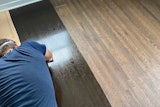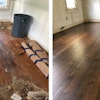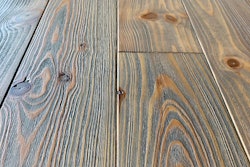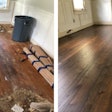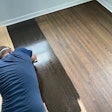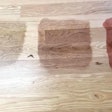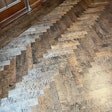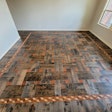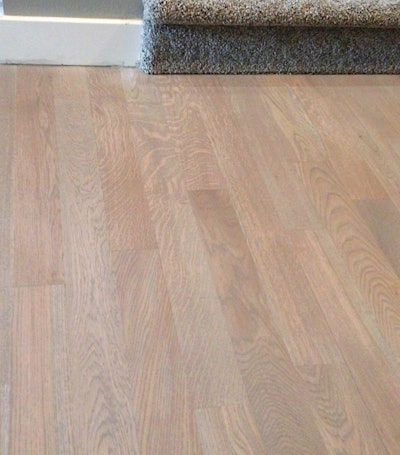
Gray stains are in demand now. If you haven't had someone ask you to stain a floor gray, be patient, it will come. We are doing another gray floor as I write this, and I put a bid in on a maple job a few days ago.
Hopefully it is a short-lived fad, but you can add to your bottom line by knowing how to successfully do these types of jobs. It can be another skill that sets yourself apart from your competition.
In this article I want to highlight the difficulty of gray stain, especially on white oak while using a water-based finish—I want you to be prepared for when it happens to you.
I'm in a service business, and so I have a hard time telling a customer "no" when they want something that shouldn't be too unreasonable. This time my customers wanted to have their prefinished white oak sanded and stained a gray color. I suggested that a water-based finish would be the best finish option to avoid the ambering effect of the conversion varnish finish we typically use in our area. Sounds reasonable enough, right?
If you go back in time to 2012, you can read an article I wrote about what can happen when you mix white oak, pastel stain and water-based finish: the dreaded tannin pull (see "A Bite that Stings" in the April/May 2012 issue). On that job we tried (twice) to stain white oak with a taupe color and use a water-based finish. Both times I had tannin pull. We ended up not staining it at all and going natural since the homeowner was insistent on having a water-based finish. I failed successfully back then, so the question now was: Would we have a repeat of my past failure, or would we achieve success?
Before I tell you about the results on this particular job, let me share our process:
Choose a color. I find the first issue you will have with a gray stain is getting the color figured out. There are definitely more than 50 shades of gray, and since men typically see color differently from women, be prepared to make a lot of stain samples. Having the homeowner find pictures online ahead of time helps narrow things down. I like to buy a bundle of matching wood and start with three to four color samples to get closer to the target, then work to adjust the color as needed.
Note your recipe. Once we have a color agreed upon, I make note of the color combination, or "recipe," so that we can duplicate it later. I like to use a quick-dry stain so I can get my customers back into their homes sooner. It's very important as you're applying the stain to keep it mixed, as the parts that make up your special color have a tendency to separate.
RELATED: Shades of Gray: How to Use Vinegar & Steel Wool to Darken a Floor
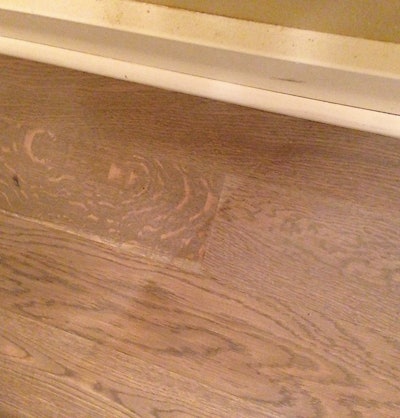 If you're not careful when doing gray stain on white oak, you end up with this - the dreaded tannin mark.
If you're not careful when doing gray stain on white oak, you end up with this - the dreaded tannin mark.
Water-pop the floor. After doing an excellent sanding job without cutting any corners, we water-pop the floor. In fact, we water-pop every stained floor we do, as I find it provides a richer, vibrant color. Your application has to be textbook, because pastels and grays are a different breed from, say, your usual Spice and Antique Browns. We have more success ragging it on and off rather than buffing it—you must be careful to get good coverage and wipe off any excess.
Lock in tannins with your sealer. After letting the stain dry an appropriate amount of time, we apply our finish. For my white oak floor, I chose a water-based sealer that has good sealing properties to lock in the tannins. This is very important, as not all sealers are created equal. Stain is not a tannin blocker, so your finish could pull tannins right through the stain and deposit it on top, leaving unsightly dark brown marks.
Apply a thin first coat. I believe the second key to a successful finish coat is to apply the first coat of sealer thin so as not to pull any tannins out that may want to get past the sealer's blockers. You can't leave any heavy spots, either, because you don't want to let tannin residue gather in one spot. Even with using a high-quality sealer that has tannin-blocking properties, you can still get a little tannin pull.
 Be sure to keep mixing your custom stain and record your exact recipe.
Be sure to keep mixing your custom stain and record your exact recipe.
Use a second sealer coat. After that first coat of sealer has dried, we apply a second coat at the recommended coverage rates. This helps fill in the thin spots left from the first coat (of course, some manufacturers recommend two coats of their sealer anyway). We then apply two coats of our finish topcoat. Sometimes an additional coat of finish may be required if you have excessive grain raise and need a little more finish so that you can buff more aggressively while being careful not to cut through the stain.
So, how did our job end up this time? We had great success. I didn't have a bunch of unsightly tannin pull marks, the stain matched the homeowners' décor perfectly, and the application of the stain was nice and even. I did see one faint tannin mark behind the toilet, but other than that we were in the clear.
How to find similar success? First, get to know and talk with the product reps. They are there to help you with any technical issues you may have and answer questions about whether their product will work in a given situation.
 A successful result with a challenging combo.
A successful result with a challenging combo.
The best place to practice and learn these techniques is at an NWFA school, where if you mess up it's not costing you hard-earned money. You get a chance to gather valuable knowledge and techniques from others in the trade. Or get a brother-in-law's floor to practice on. If you have the room, make up a sample panel on a couple of sheets of plywood and practice different stains and techniques of application to get the hang of it before it really counts.
Gray stains and other even wilder and more unusual colors and finish techniques are getting popular, so talk to your reps and practice until you learn to do these colors with confidence. Once you do, you'll see your profits increase along with your skills.











